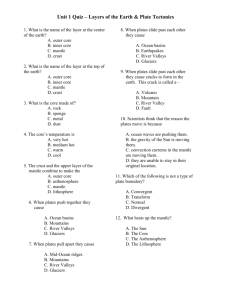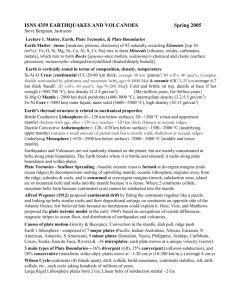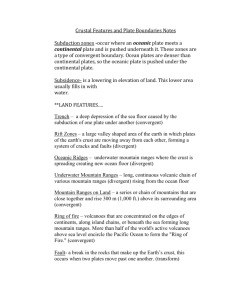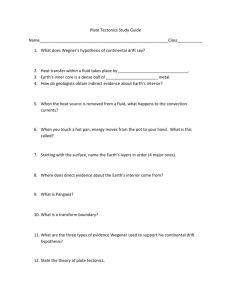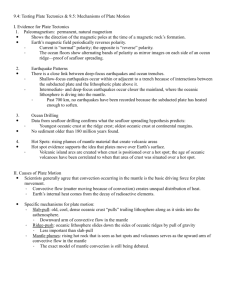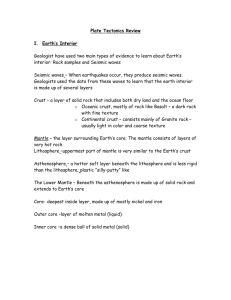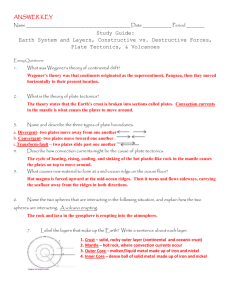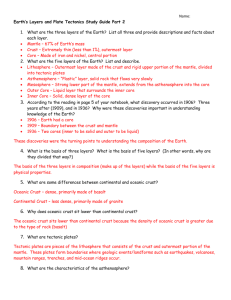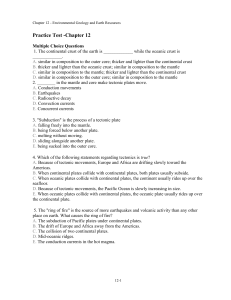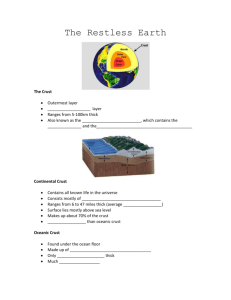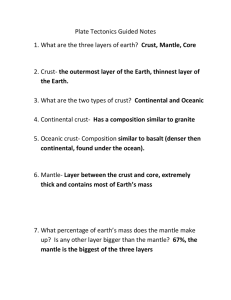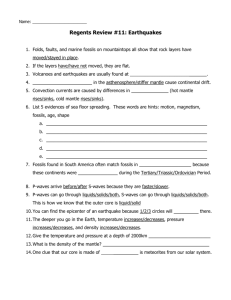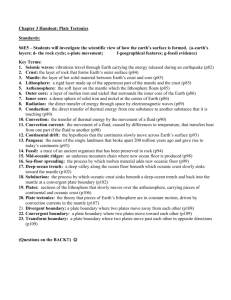Benchmark 3 Answer Key
advertisement
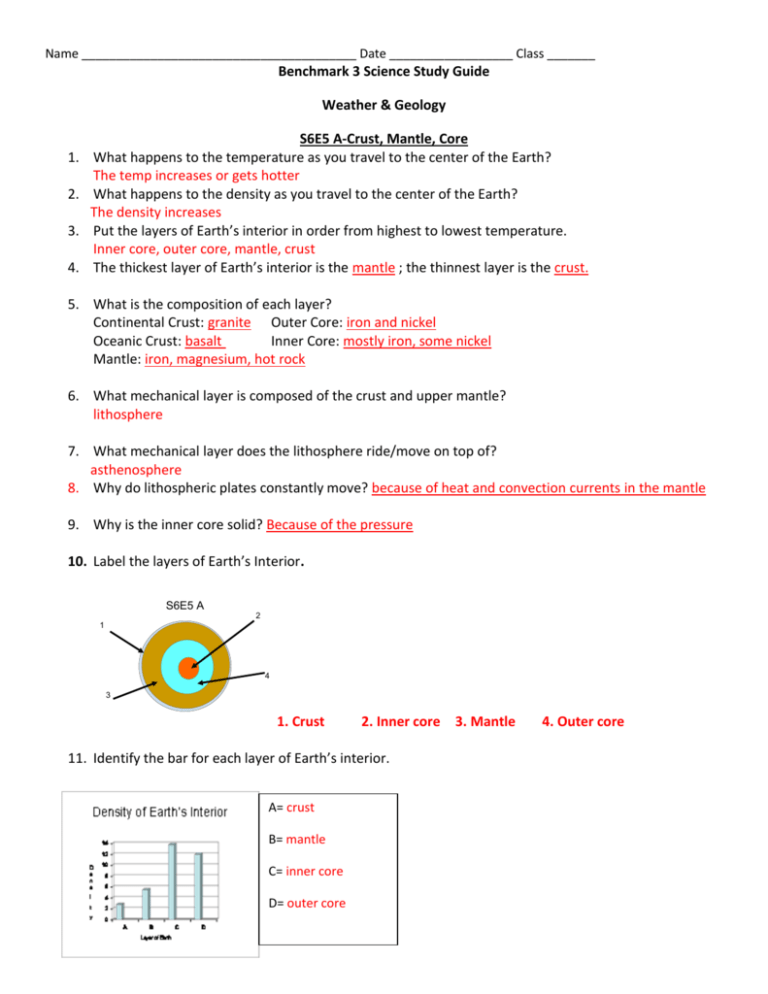
Name ________________________________________ Date __________________ Class _______ Benchmark 3 Science Study Guide Weather & Geology 1. 2. 3. 4. S6E5 A-Crust, Mantle, Core What happens to the temperature as you travel to the center of the Earth? The temp increases or gets hotter What happens to the density as you travel to the center of the Earth? The density increases Put the layers of Earth’s interior in order from highest to lowest temperature. Inner core, outer core, mantle, crust The thickest layer of Earth’s interior is the mantle ; the thinnest layer is the crust. 5. What is the composition of each layer? Continental Crust: granite Outer Core: iron and nickel Oceanic Crust: basalt Inner Core: mostly iron, some nickel Mantle: iron, magnesium, hot rock 6. What mechanical layer is composed of the crust and upper mantle? lithosphere 7. What mechanical layer does the lithosphere ride/move on top of? asthenosphere 8. Why do lithospheric plates constantly move? because of heat and convection currents in the mantle 9. Why is the inner core solid? Because of the pressure 10. Label the layers of Earth’s Interior. S6E5 A 2 1 4 3 1. Crust 2. Inner core 3. Mantle 11. Identify the bar for each layer of Earth’s interior. A= crust B= mantle C= inner core D= outer core 4. Outer core Name ________________________________________ Date __________________ Class _______ S6E5e/f Lithospheric Plate Movement/Geologic features 12. Name the plate movement associated with each picture below a. b. divergent c. convergent convergent with subduction d. transform 13. What geological features are created at convergent boundaries? Mountains (2 continental plates), trenches (oceanic and oceanic plate), volcanoes (continental and oceanic plate) 14. What geological features are created at divergent boundaries? Sea floor spreading- makes mid ocean ridges (2 oceanic plates dividing) Rift valley (2 continental plates dividing) 15. What geological event takes place at transform boundaries? Major earthquakes 16. What geological features are created at convergent boundaries with subduction? Volcanic islands, volcanoes, trenches 17. What causes plate tectonic movement? Convection currents and heat 18. What are plates that move beneath another plate called? Why does this occur? Subduction… it happens because one plate is more dense than the other plate. 19. What is the Theory of Continental Drift? Who is responsible for this theory? All the continents were once all together and then they drifted apart and Alfred Wegner is responsible for this theory. 20. List 3 examples of evidence that supported Continental Drift Theory. Fossils, climate change, rocks, the shape of the continents. Name ________________________________________ Date __________________ Class _______ S6E5g Fossils 21. What is the law of superposition? Fossils and rock layers are older at the bottom and younger at the top layers 22. What are 2 examples of fossil evidence that supports climate change? The warm weather fern (Glossopteris) fossil was found on Antarctica. Australia use to be in the arctic regions, now it is closer to the equator. 23. What are 2 examples of fossil evidence that supports the changing of Earth’s surface? The fresh water reptile (Mesosaurus) and the same rocks were found on different continents, AND Providence Canyon was once under water. Weather Review 24. What are the 3 types of heat transfer? Radiation, conduction, convection 25. Describe each type of heat transfer. Radiation- Heat travels in the forms of waves through a vacuum. Conduction- Heat travels by touch or contact from one object to another object. Convection- Heat travels in circular pattern, warm air rises and cold air sinks. 26. Why does land and water absorb heat at different rates? Because land heats up faster than water and land cools down faster than water. 27. Which heats up faster? Land Which cools faster? Land 28. What causes wind? The unequal heating of the earth, change in pressure, wind blows from high pressure to low pressure 29. Describe convection currents. The movement of liquids or gases in a circular motion- when a hot, less dense air rises, cold; more dense air sinks. 30. Describe each of the global winds and pressure bands. (Polar Easterlies, Prevailing Westerlies, Trade Winds and Horse Latitudes, Doldrums) Polar easterlies- travel between 90 degrees to 60 degrees- moves from H to L in both hemispheres Prevailing Westerlies- travel between 60 degrees-30 degree- moves from H to L in both hemispheres Trade Winds- travel between 30 degrees-0 degrees- moves from H to L in both hemispheres Horse Latitudes- an area of High pressure that happens at 30 degrees in both hemispheres Doldrums- an area of low pressure that happens around the equator. Name ________________________________________ Date __________________ Class _______ 31. Draw and describe what happens in a cold front? Cold air mass moves in and pushes the warm air mass up 32. What type of clouds form when a cold front occurs? Cumulonimbus clouds 33. What triggers/causes thunderstorms and tornadoes? Cold front- warm air being pushed up to cause cumulonimbus clouds 34. What causes the most damage during a hurricane? The thunderstorm bands can cause a lot of damage with wind and heavy rain 35. What is the fuel or energy of a hurricane? Warm ocean water 36. Where do most hurricanes that hit the Eastern United States form? In the Atlantic Ocean that is close to the equator. 37. How do hurricanes and tornadoes differ? Tornadoes form on land and hurricanes form in warm ocean water 38. Draw and label the parts of a hurricane. Name ________________________________________ Date __________________ Class _______





